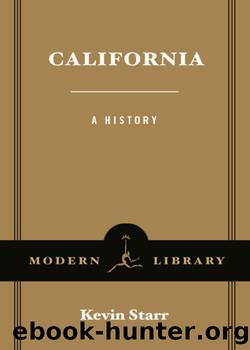California by Kevin Starr

Author:Kevin Starr
Language: eng
Format: mobi, epub
Tags: Nonfiction
ISBN: 9780307430755
Publisher: Random House Publishing Group
Published: 2007-12-17T21:00:00+00:00
8
MAKING IT HAPPEN
Labor Through the Great Depression and Beyond
Preparing citrus for shipment, the early 1930s CALIFORNIA STATE LIBRARY
The Great Depression came late to California, and it came more subtly because the California economy was diversified into agricultural, industrial, entertainment, tourist, and service sectors; hence it could not be crippled as completely as was the case in many of the industrialized states of the Northeast, so dependent upon manufacture, or Midwestern states whose economy was based on agriculture. Nevertheless, the Depression did come to California by the early 1930s, and the resulting social strife was compounded by the structural instability of the agricultural workforce; a militant labor movement in the San Francisco Bay Area; a labor-resistant oligarchy, especially in Southern California; and, among working people, a radical tradition going back to the nineteenth century.
The sandlot riots in San Francisco in the 1870s and the brief influence of the Workingmen’s Party leading up to the second constitutional convention underscored the foundations of California in labor. The Gold Rush was an epic of personal labor in which men of every social background sought their fortunes through the work of their hands. In the Mother Lode, it was no disgrace to do physical work, and this inserted a labor-oriented egalitarianism into the California formula. Those who remained in the service economy during this period, meanwhile, were doing extremely well through the work of their hands. A carpenter could make as much as $14 a day as of 1849. An unskilled laborer could make up to $8, and a skilled washerwoman could charge up to $20 to do a load of laundry. Since labor for hire in the cities and towns was scarce—most people preferring to be in the mines—the workers of California organized themselves almost immediately. The carpenters and joiners of San Francisco, for example, struck for $16 a day in November 1849 and received something approaching that compensation. By 1859, the topographers and teamsters of San Francisco had organized the first two labor unions in the state. As the manufacturing sector developed—stimulated by the rise of, among other enterprises, the Union Iron Works of San Francisco—so, too, did the union movement keep pace. By 1863, San Francisco had the Trade Union Council representing fifteen labor organizations and as many as three thousand workers. Even Chinese workers, who later bore the brunt of white trade unionist resentment, organized. In June 1867 the Chinese struck the Central Pacific, demanding twelve-hour days and $40 a month. The demand by organized labor for an eight-hour day was pioneered in the mid-1860s in San Francisco. As a political force, the eight-hour crusade helped send Irish-born Eugene Casserly, a Democrat, to the U.S. Senate in 1869.
The developing strength of the unionist movement in San Francisco during the 1860s set the stage for the violence and turmoil of the 1870s when a nationwide depression destroyed the local economy and San Francisco was already filled with former railroad construction workers, now the angry unemployed. The Chinese were seen as a special threat.
Download
This site does not store any files on its server. We only index and link to content provided by other sites. Please contact the content providers to delete copyright contents if any and email us, we'll remove relevant links or contents immediately.
| Archaeology | Essays |
| Historical Geography | Historical Maps |
| Historiography | Reference |
| Study & Teaching |
Underground: A Human History of the Worlds Beneath Our Feet by Will Hunt(12052)
Sapiens by Yuval Noah Harari(5323)
Navigation and Map Reading by K Andrew(5133)
The Sympathizer by Viet Thanh Nguyen(4342)
Barron's AP Biology by Goldberg M.S. Deborah T(4122)
5 Steps to a 5 AP U.S. History, 2010-2011 Edition (5 Steps to a 5 on the Advanced Placement Examinations Series) by Armstrong Stephen(3708)
Three Women by Lisa Taddeo(3393)
Water by Ian Miller(3155)
The Comedians: Drunks, Thieves, Scoundrels, and the History of American Comedy by Nesteroff Kliph(3056)
Drugs Unlimited by Mike Power(2565)
A Short History of Drunkenness by Forsyth Mark(2259)
DarkMarket by Misha Glenny(2194)
The House of Government by Slezkine Yuri(2178)
And the Band Played On by Randy Shilts(2166)
The Library Book by Susan Orlean(2052)
Revived (Cat Patrick) by Cat Patrick(1974)
The Woman Who Smashed Codes by Jason Fagone(1945)
Birth by Tina Cassidy(1884)
The Absolutely True Diary of a Part-Time Indian by Sherman Alexie(1881)
